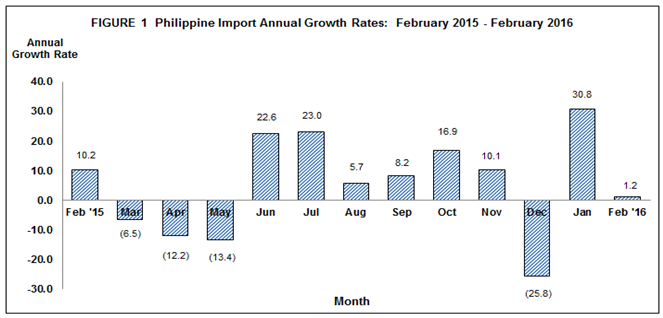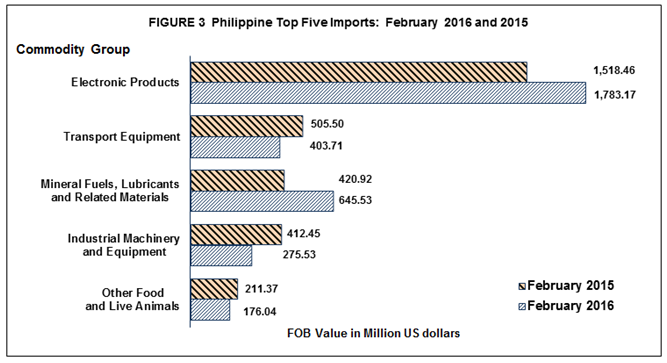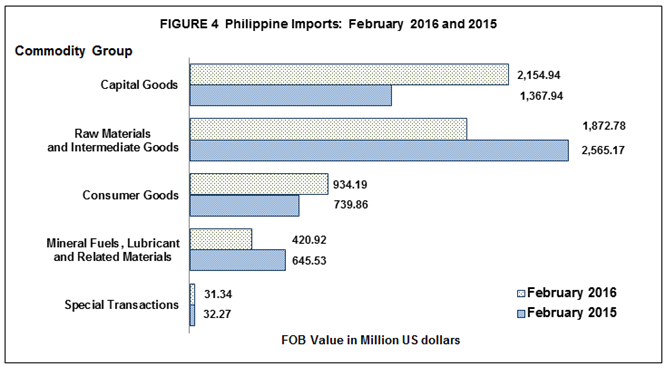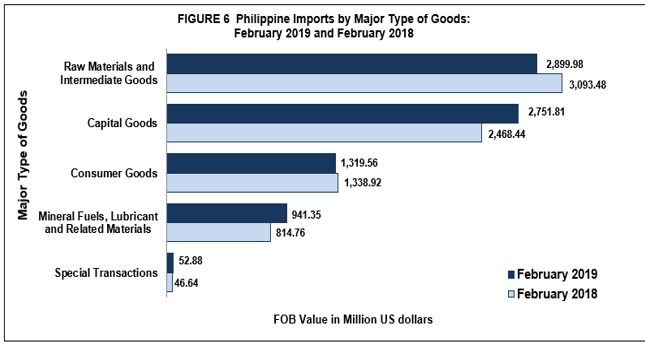EXTERNAL TRADE PERFORMANCE
FEBRUARY 2016
(Preliminary)
|
|
February
|
||
|---|---|---|---|
|
|
2016 p |
2015 r |
|
|
TOTAL IMPORTS FOB Value in Million US Dollars Year-on-Year Growth (Percent) Electronic Products FOB Value in Million US Dollars Year-on-Year Growth (Percent) |
5,414.18 1.2
1,518.46 -14.8 |
5,350.77 10.2
1,783.17 34.6 |
|
|
Top 10 Philippine Imports from All Countries: February 2016 p
(Year-on-Year Growth in Percent)
|
|||
|---|---|---|---|
Gainers |
Losers |
||
|
Telecommunication Equipment and Electrical Machinery
|
77.5 |
Mineral Fuels, Lubricants and Related Materials
|
-34.8 |
|
Industrial Machinery and Equipment
|
49.7 |
Electronic Products
|
-14.8 |
|
Medicinal and Pharmaceutical Products
|
41.4 |
Iron and Steel
|
-12.5 |
|
Transport Equipment
|
25.2 |
|
|
|
Miscellaneous Manufactured Articles |
22.3 |
|
|
|
Other Food and Live Animals
|
20.1 |
|
|
|
Plastics in Primary and Non-Primary Forms
|
5.5 |
|
|
p-preliminary, r-revised

IMPORTS INCREASE BY 1.2 PERCENT IN FEBRUARY 2016
The total imported goods by the country for the month of February 2016 amounted to $5.414 billion, an increase of 1.2 percent from $5.351 billion recorded during the same period a year ago. The increase was due to the positive performance of seven out of the top ten major imported commodities for the month led by telecommunication equipment and electrical machinery (77.5%). The other six positive performers were: industrial machinery and equipment (49.7%), medicinal and pharmaceutical products (41.4%), transport equipment (25.2%), miscellaneous manufactured articles (22.3%), other food and live animals (20.1%), and plastics in primary and non-primary forms (5.5%). (Table 2)
Cumulative imports for January to February 2016 amounted to $12.239 billion and showed a 15.8 percent increase compared with $10.569 billion in the same period of last year.
The balance of trade in goods (BOT-G) for the Philippines in February 2016, registered a deficit of $1.104 billion, higher than the $837.37 million trade deficit in the same month last year. (Table 1)

ELECTRONIC PRODUCTS ACCOUNT FOR 28.0 PERCENT OF IMPORT BILL
Total payment for the country’s top ten imports for February 2016 reached $3.867 billion or 71.4 percent of the total import bill. (Table 2)
Inbound shipments of Electronic Products in February 2016 accounted for 28.0 percent of the total import bill with value amounting to $1.518 billion. It decreased by 14.8 percent over the last year's figure of $1.783 billion. Components/Devices (Semiconductors), although had the biggest share of 19.2 percent among electronic products, went down by 28.3 percent from $1.450 billion in February 2015 to $1.040 billion in February 2015.
Transport Equipment, contributing 9.3 percent to the total import bill was the country’s second top import for the month amounting to $505.50 million. It grew by 25.2 percent compared to last year’s value of $403.71 million.
Minerals Fuels, Lubricants and Related Materials placed third with 7.8 percent share to total imports valued at $420.92 million. This registered a decrease of 34.8 percent from its previous year’s level of $645.53 million.
Imports of Industrial Machinery and Equipment ranked fourth with 7.6 percent share and reported value of $412.45 million in February 2016. It accelerated by 49.7 percent from $275.53 million in February 2015.
Other Food and Live Animals ranked fifth, with 3.9 percent share to the total imports which was valued at $211.37 million in February 2016. It registered a 20.1 percent increase from its year ago level of $176.04 million.
Rounding up the list of the top ten imports for February 2016 were:
- Telecommunication Equipment and Electrical Machinery valued at $190.93 million
- Iron and Steel, $184.84 million
- Miscellaneous Manufactured Articles, $163.83 million
- Plastics in Primary and Non-Primary Forms, $138.74 million
- Medicinal and Pharmaceutical Products, $120.17 million.

PURCHASES OF CAPITAL GOODS ACCOUNT FOR 39.8 PERCENT OF THE TOTAL IMPORTS
Payments for inward shipments of Capital Goods accounted for 39.8 percent of the total imports. It increased by 57.5 percent to $2.155 billion in February 2016 from $1.368 billion in February 2015. (Table 3)
Total importation of Raw Materials and Intermediate Goods in February 2016 were valued at $1.873 billion, accounting for 34.6 percent share of the total imports. It decreased by 27.0 percent over last year's figure of $2.565 billion. Semi-Processed Raw Materials, having the biggest share of this commodity group at 31.4 percent was valued at $1.701 billion. It went down by 28.0 percent compared from $2.362 billion in February 2015.
Purchases of Consumer Goods recorded 17.3 percent share with a total import bill valued at $934.19 million in February 2016. It recorded a positive growth of 26.3 percent from $739.86 million registered in February 2015.
Mineral Fuels, Lubricants and Related Materials with 7.8 percent share to total imports, decreased by 34.8 percent from $645.53 million in February 2015 to $420.92 million in February 2016. Other mineral fuel and lubricants such as gas oils, regular and premium unleaded motor spirit and aviation spirit contributed the biggest share of imports in this commodity group at 3.9 percent and valued $212.82 million. (Table 3)
Furthermore, imports of Special Transactions went down by 2.9 percent from $32.27 million recorded in February 2015 to $31.34 million in February 2016.

IMPORTS FROM PEOPLE’S REPUBLIC OF CHINA ACCOUNT FOR 16.7 PERCENT
Aggregate payments from the top ten imports sources for February 2016 amounted to $4.226 billion or 78.0 percent of the total. (Table 4)
People’s Republic of China remained as the country’s biggest source of imports at 16.7 percent share in February 2016. Payments were recorded at $905.48 million, an increase of 3.5 percent from $874.59 million in February 2015. Revenue from the country’s exports to People’s Republic of China, on the other hand, reached $392.92 million, generating a total trade value of $1.298 billion and $512.57 million trade deficit. (Table 5)
Japan including Okinawa came second, contributing 12.6 percent or $684.69 million to the total import bill in February 2016. It grew by 65.5 percent from its February 2015 value of $413.63 million. Export receipts from Japan in February 2016 reached $939.61 million yielding a total trade value of $1.624 billion and a favourable balance of trade of $254.92 million. (Tables 4 and 4a)
United States of America (USA), including Alaska and Hawaii, was the third biggest source of imports for February 2016 with 9.5 percent share to the total import bill amounting to $513.35 million, a decrease of 15.7 percent from $609.14 million in February 2015. Exports to USA amounted to $743.04 million, yielding a two-way trade value of $1.256 billion and a trade surplus of $229.69 million.
Thailand ranked fourth, accounting for 8.9 percent share of the total import bill in February 2016, a positive growth of 39.8 percent to $483.50 million in February 2016 from $345.83 million in February 2015. Exports to this country amounted to $161.56 million resulting to a total trade value of $645.06 million and a trade deficit of $321.94 million.
Republic of Korea placed fifth, accounting for 7.0 percent share of the total import bill worth $377.67 million in February 2016, it went up by 17.5 percent from $321.53 million in February 2015. Exports to Republic of Korea amounted to $186.41 million resulting to a total trade value of $564.08 million and a trade deficit of $191.25 million. (Tables 4 and 4a).
Other major sources of imports for the month of February 2016 included in Top Ten Countries were: Singapore, $349.56 million; Taiwan, $318.01 million; Indonesia, $254.61 million; Malaysia (includes Sabah and Sarawak), $208.77 million; and Vietnam, $129.93 million.
Moreover, imports from Other Countries valued at $1.189 billion and accounted for 22.0 percent from the total imports for the month of February 2016. Among the other countries, Hong Kong recorded the highest import sources at $122.48 million or 2.3 percent from the total.

IMPORTS FROM COUNTRIES IN EAST ASIA ACCOUNT FOR 44.6 PERCENT
By economic bloc, East Asia (China, Hong Kong, Japan, Macau, Mongolia, North Korea, South Korea and Taiwan) was the biggest source of the country’s imports in February 2016 as it accounted for 44.6 percent of the total imports valued at $2.417 billion. It increased by 8.9 percent from $2.220 billion in February 2015. Total exports to countries of East Asia amounted to $2.084 billion resulting to a total trade of $4.502 billion and a trade deficit of $332.92 million. (Table 4a and 5a)
Commodities imported from ASEAN member countries were valued at $1.429 billion, contributing 26.4 percent share to total and registered an increase of 10.4 percent from $1.294 billion recorded in February 2015. Proceeds from exports to ASEAN member countries were worth $667.25 million, resulting to a total trade of $2.096 billion and a trade deficit of $761.25 million. (Table 4a and 5a)
Imports from European Union were valued at $433.76 million. It dropped by 29.4 percent compared to a year ago value of $614.06 million. Exports to member countries of European Union were worth $550.28 million, resulting to a total trade of $984.04 million and a trade surplus of $116.52 million. (Table 4a and 5a)

Technical Notes
Import trade statistics are compiled by the Philippine Statistics Authority (PSA) from copies of import documents submitted to the Bureau of Customs (BOC) by importers or their authorized representatives as required by law. PSA collects a copy of the accomplished forms by the importer. These are the following import documents collected and processed by PSA:
1. Import Entry & Internal Revenue Declaration (BOC IEIRD Form 236)
2. Informal Import Declaration and Entry (BOC Form 177)
3. PEZA Warehousing Entry (BOC Form 242 CEWE)
Moreover, an electronic copy of the IEIRD, or called Single Administrative Document (SAD), is utilized to capture the monthly import figures. SAD-IEIRD is an on-line submission of import documents either by brokers or companies. These are transactions that pass through the Automated Cargo Operating System (ACOS) or now called the e2m (electronic to mobile) customs system; a system implemented through the BOC e-Customs Project. The output of this system is provided by BOC to PSA on a monthly basis through email.
All documents (hard copies and e-files) received before the cut-off date which is every 10th day of the month are compiled, processed and generated in a monthly statistical tables for the preparation of Press Release. All documents received after the cut-off date, however, are processed and included in the generation of the revised statistical tables. Processing includes coding, editing, review and validation. Revised statistical tables are made available 10 to 15 working days after the press release date.
The Press Release is due every 25th day of each month. However, if the 25th day falls on a Saturday, release will be on Friday but if it falls on a Sunday or Monday the release will be on Tuesday. If the release date falls on holiday, the date of release is moved accordingly.
The 2004 Philippine Standard Commodity Classification (PSCC) is used to classify the imported commodities at the most detailed level for statistical purposes.
Data request of international merchandise trade statistics are available at Philippine Statistics Authority, Economic Sector Statistics Service, Trade Statistics Division (Telephone Number: 376-19-75).
FOR THE NATIONAL STATISTICIAN:
